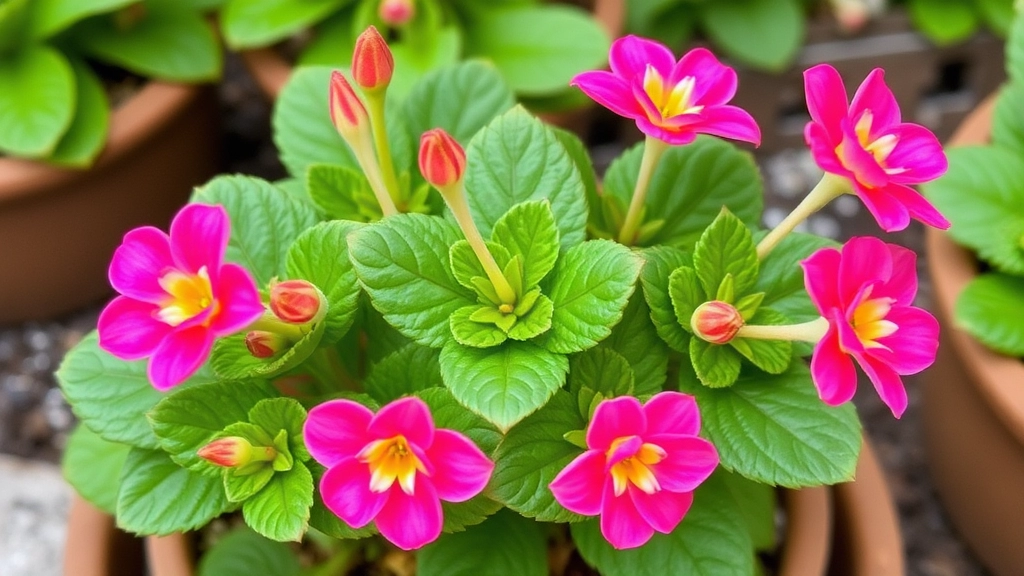Kalanchoe Copper Spoons Flower
If you’re like me and fascinated by unique succulents, the Kalanchoe Copper Spoons Flower, also known as Kalanchoe orgyalis, is a must-have for your collection. This plant is renowned for its striking copper-coloured leaves that resemble spoons, adding a touch of elegance to any garden or indoor space.
Care Essentials
Understanding the care essentials for Kalanchoe Copper Spoons is key to ensuring it thrives. This succulent prefers bright, indirect sunlight and well-draining soil to prevent root rot. Watering should be moderate; let the soil dry out completely between waterings. With the right conditions, you can enjoy not only its beautiful foliage but also its charming yellow flowers.
Growing and Maintaining
Let’s dive into the specifics of how to grow and maintain this captivating plant.
When considering adding a unique touch to your indoor garden, Kalanchoe Copper Spoons often comes to mind. This succulent, known scientifically as *Kalanchoe orgyalis*, is celebrated for its striking appearance and hardy nature.
### Key Features
– **Leaf Structure:** The leaves are thick, fleshy, and have a distinctive spoon shape. Their glossy, coppery hue gives them a metallic appearance, which stands out beautifully in any plant collection.
– **Growth Habit:** Copper Spoons typically grow upright, reaching heights of around 30 cm (12 inches). Their compact form makes them ideal for small spaces.
– **Texture and Colour:** The leaves are covered in a fine layer of fuzz, which adds to their unique texture. The copper colour deepens with exposure to sunlight, enhancing their visual appeal.
– **Flowering:** While primarily grown for their foliage, Kalanchoe Copper Spoons can produce clusters of small, tubular flowers in shades of orange and yellow, typically in late winter or early spring.
These characteristics not only make Kalanchoe Copper Spoons a visual delight but also a resilient choice for both novice and experienced plant enthusiasts. For more detailed care tips, you might find our [Ultimate Guide to Fuzzy Kalanchoe Care Tips](https://planthq.org/ultimate-guide-to-fuzzy-kalanchoe-care-tips/) helpful. Additionally, if you’re interested in exploring more about the various kalanchoe varieties, check out our [Kalanchoe Succulent Identification Guide](https://planthq.org/kalanchoe-succulent-identification-guide-top-varieties-traits/).
Ideal Growing Conditions
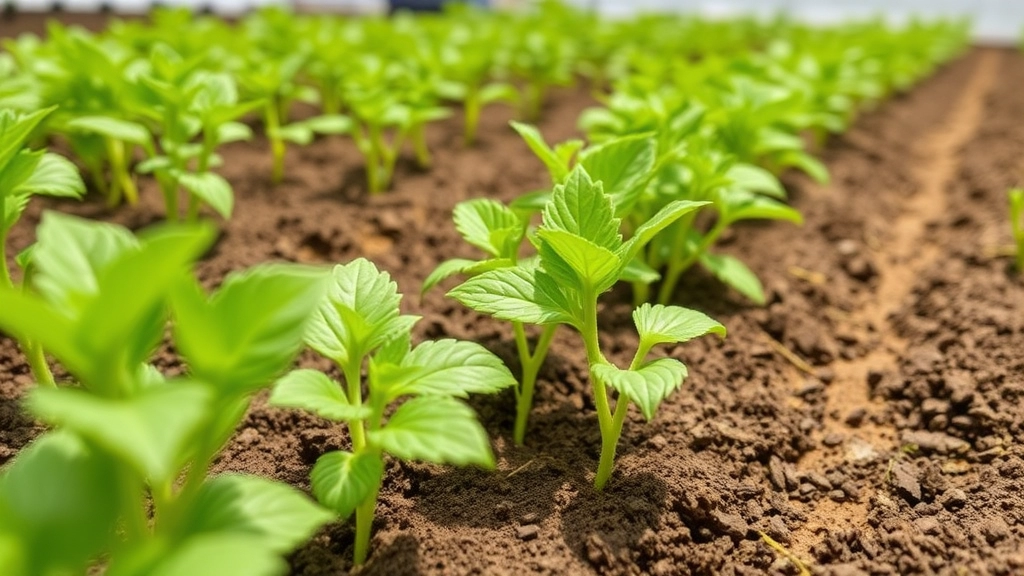
So, you’ve got your Kalanchoe Copper Spoons, and now you’re wondering: what’s the best way to help these beauties thrive?
The ideal growing conditions for Kalanchoe Copper Spoons are pretty straightforward. These plants love a warm, sunny environment that mimics their native habitat. Here’s what you need to know:
- Temperature: Aim for a cozy range between 20°C to 30°C (68°F to 86°F). They’re not fans of the cold, so keep them away from chilly drafts or frost.
- Humidity: They prefer low humidity. A dry atmosphere is perfect for them, so if you live in a humid area, make sure to keep them well-ventilated.
- Light: Bright, indirect sunlight is the magic ingredient. They can handle direct sun for a few hours, but too much can scorch those lovely leaves.
- Space: Give them room to breathe! A little space around each plant helps with air circulation and keeps them healthy.
By setting up these ideal conditions, you’re well on your way to having a thriving Kalanchoe Copper Spoons plant.
When it comes to growing Kalanchoe Copper Spoons, understanding their light and temperature preferences is crucial. Many plant enthusiasts often wonder why their Copper Spoons aren’t thriving.
### Light Requirements:
Kalanchoe Copper Spoons thrive best in bright, indirect sunlight. Here are some key points to consider:
– **Ideal Location:** Place your plant near a south or west-facing window.
– **Direct Sunlight:** While they can tolerate some direct sunlight, prolonged exposure may scorch their leaves.
– **Low Light Conditions:** Avoid low-light environments, as this can lead to leggy growth and poor health.
### Temperature Preferences:
Temperature plays a significant role in the overall health of your Copper Spoons.
– **Optimal Range:** They prefer temperatures between 18°C to 24°C (65°F to 75°F).
– **Cold Sensitivity:** Temperatures below 10°C (50°F) can be detrimental, so ensure they are protected from chilly drafts.
– **Humidity Levels:** Kalanchoe Copper Spoons enjoy moderate humidity but can adapt to drier conditions.
For more detailed care tips, you might want to check out our [ultimate guide to flowering Kalanchoe care tips for blooming](https://planthq.org/ultimate-guide-to-flowering-kalanchoe-care-tips-for-blooming/) and learn [how to propagate Kalanchoe Copper Spoons cuttings](https://planthq.org/how-to-propagate-kalanchoe-copper-spoons-cuttings/).
Watering Needs
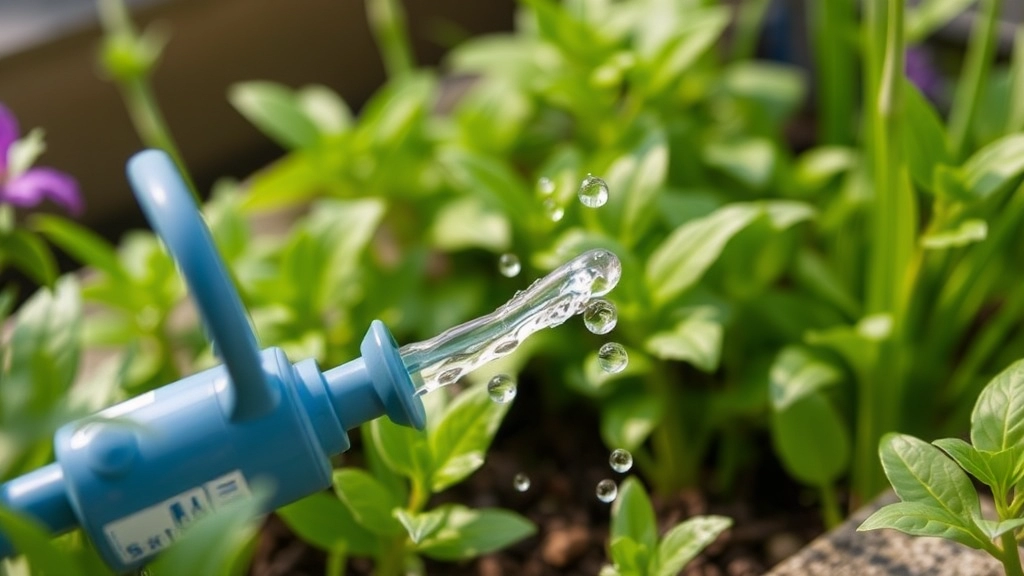
When it comes to caring for your Kalanchoe Copper Spoons, understanding its watering needs is crucial. Many plant enthusiasts often worry about overwatering or underwatering, which can lead to root rot or dehydration.
Key Watering Tips:
- Frequency: Water your Copper Spoons every 2-3 weeks during the growing season (spring and summer). In the dormant months (autumn and winter), reduce watering to once a month.
- Soil Check: Always check the top inch of soil. If it feels dry, it’s time to water. If it’s still moist, hold off for a few more days.
- Watering Technique: Water thoroughly until it drains out of the bottom. This ensures the roots receive adequate moisture without sitting in water.
- Humidity Considerations: Kalanchoe Copper Spoons thrive in low humidity. Avoid misting, as excess moisture can lead to fungal issues.
- Signs of Overwatering: Yellowing leaves or a mushy stem are indicators of overwatering. Adjust your schedule accordingly.
By mastering these watering techniques, you can help your Kalanchoe Copper Spoons flourish.
When it comes to growing Kalanchoe Copper Spoons, the right soil and drainage are crucial for its health and vitality.
Have you ever struggled with overwatered plants or poor growth due to inadequate soil conditions?
**Soil Composition:**
– Kalanchoe Copper Spoons thrive in well-draining soil.
– A cactus or succulent mix is ideal, as it allows for proper airflow and prevents root rot.
– You can also create your own mix using:
– 50% potting soil
– 25% perlite
– 25% coarse sand
**Drainage:**
– Good drainage is essential.
– Ensure your pot has drainage holes to allow excess water to escape.
– Consider adding a layer of gravel or small stones at the bottom of the pot for added drainage.
For a more detailed guide on how to ensure proper drainage and avoid overwatering, you can refer to the [complete care guide for Kalanchoe Panda Plant](https://planthq.org/complete-care-guide-for-kalanchoe-panda-plant/).
**Pot Selection:**
– Choose pots made from materials like terracotta or ceramic.
– These materials allow moisture to evaporate more quickly than plastic pots, reducing the risk of soggy soil.
Additionally, if you’re interested in learning more about different Kalanchoe varieties and their specific care requirements, check out this [comprehensive guide on Kalanchoe Paddle Plant care](https://planthq.org/kalanchoe-paddle-plant-care-comprehensive-guide-tips/).
Fertilization Tips for Kalanchoe Copper Spoons
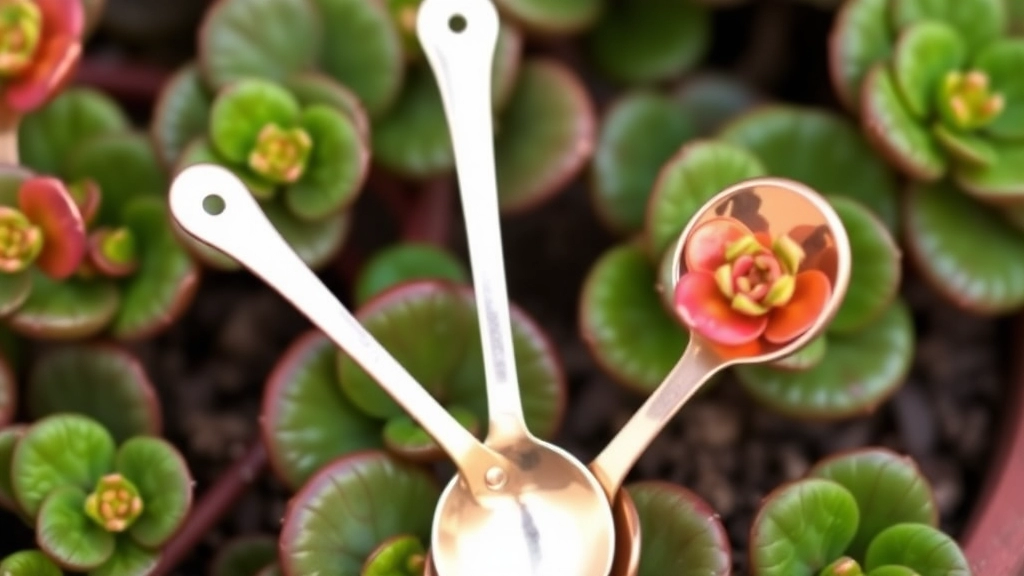
So, you’re wondering how to keep your Kalanchoe Copper Spoons thriving, right?
Fertilization is key to ensuring these beauties stay vibrant and healthy.
- Frequency: Feed your Copper Spoons every 4-6 weeks during the growing season (spring and summer). They don’t need much, so don’t overdo it!
- Type of Fertilizer: A balanced, water-soluble fertilizer works wonders. Look for one with an NPK ratio of 10-10-10 or similar.
- Dilution: Always dilute the fertilizer to half the recommended strength. These plants are sensitive and can get burned if you go too strong.
- Application: Apply the fertilizer to damp soil. This helps prevent root burn and ensures even distribution.
- Signs of Over-Fertilization: If you notice brown leaf tips or a crusty residue on the soil, you might be feeding too much. Time to scale back!
- Organic Options: If you prefer a more natural approach, consider using compost or a diluted liquid seaweed solution. Your plants will love the extra nutrients!
Pest and Disease Management
As we delve into pest and disease management for Kalanchoe Copper Spoons, it’s essential to understand the potential threats these plants may face.
Common Pests
- Mealybugs: These tiny, white insects often hide in leaf axils and can cause significant damage.
- Aphids: Small and green, aphids suck the sap from leaves, leading to wilting and stunted growth.
- Spider Mites: These pests thrive in dry conditions and can create fine webs on the plant.
Signs of Infestation
- Yellowing leaves
- Stunted growth
- Sticky residue on leaves (honeydew)
Disease Risks
Kalanchoe Copper Spoons can also be susceptible to diseases, particularly fungal infections.
Propagation Methods for Kalanchoe Copper Spoons
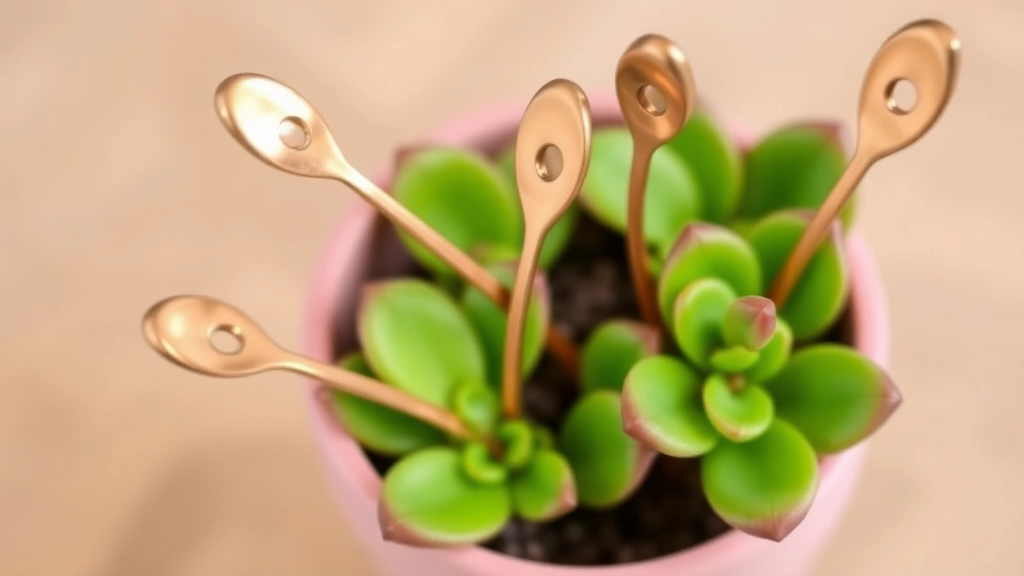
So, you’ve got your Kalanchoe Copper Spoons thriving, and now you’re wondering how to multiply that joy?
Propagation is a fantastic way to expand your collection or share the love with friends.
Here are some simple methods to get you started:
Leaf Cuttings
- Choose a Healthy Leaf: Pick a plump, healthy leaf from your plant.
- Cut and Dry: Use a clean knife to cut the leaf. Let it dry for a day or two to form a callus.
- Plant It: Place the leaf on top of well-draining soil and lightly press it down. Water sparingly.
- Watch for Roots: In a few weeks, you’ll see tiny roots and new growth.
Stem Cuttings
- Select a Stem: Look for a stem that’s at least a few inches long.
- Cut and Dry: Cut it below a leaf node and let it dry for a day.
- Plant It: Insert the cutting into soil, ensuring the node is buried.
- Keep It Moist: Water lightly and place it in bright, indirect light.
Offsets
- Look for Offsets: These are little babies that grow at the base of the plant.
- Gently Remove: Carefully separate them from the parent plant.
- Let Them Callus: Allow them to dry for a day or two.
- Plant: Place them in their own pots with well-draining soil.
Tips for Success
- Humidity: Keep the environment humid to encourage rooting.
- Temperature: Aim for a warm spot, ideally between 20°C to 25°C.
- Patience: It may take a few weeks, but don’t rush it!
Seasonal Care for Kalanchoe Copper Spoons
As we transition through the seasons, Kalanchoe Copper Spoons require tailored care to thrive. Have you ever wondered how to keep your plants vibrant all year round? Let’s explore the seasonal needs of this unique succulent.
Flowering Patterns of Kalanchoe Copper Spoons
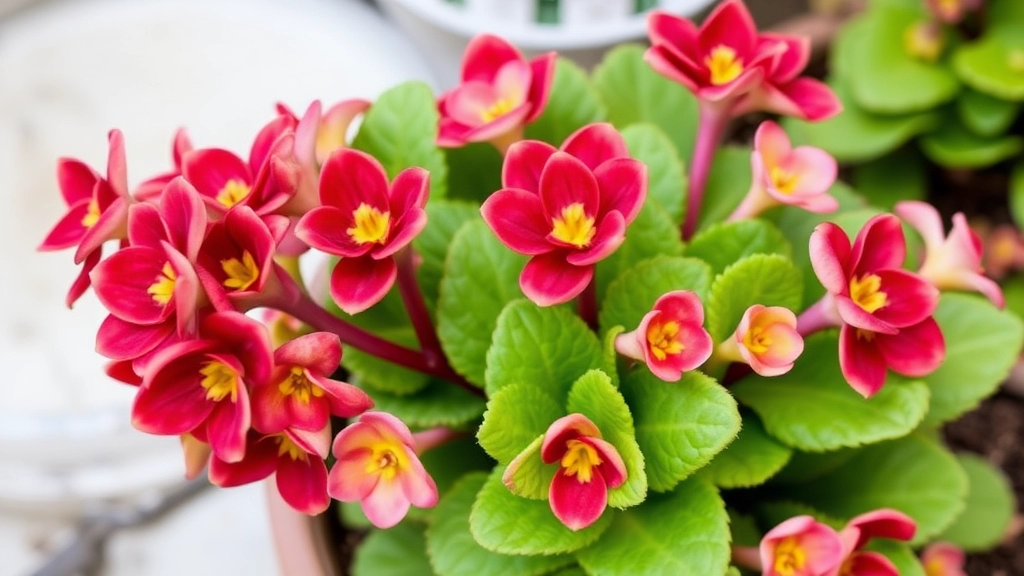
So, you’ve got your Kalanchoe Copper Spoons thriving, and now you’re wondering about those beautiful flowers, right?
Well, let’s dive into what you can expect when it comes to their flowering patterns.
When Do They Flower?
Kalanchoe Copper Spoons typically bloom in late winter to early spring.
This is when you’ll see those lovely clusters of small, tubular flowers appearing.
What Do the Flowers Look Like?
- Shape: The flowers are usually bell-shaped.
- Colour: They can range from vibrant reds to yellows and even whites.
- Size: They’re not massive, but they sure pack a punch in terms of beauty!
How to Encourage Flowering
If you want to coax those blooms out, here are a few tips:
- Light: Ensure your plant gets plenty of bright, indirect sunlight.
- Temperature: Keep them in a warm spot; they love that!
- Watering: Don’t overdo it. Let the soil dry out between waterings.
Why Aren’t They Flowering?
Sometimes, you might find your Copper Spoons are a bit shy about blooming.
Here are some reasons why:
- Insufficient Light: If they’re not getting enough light, they may skip flowering.
- Too Much Water: Overwatering can stress the plant and stop it from blooming.
- Nutrient Deficiency: A lack of nutrients can also cause flowering issues.
Pruning and maintenance are essential for keeping your Kalanchoe Copper Spoons healthy and vibrant. You might be wondering how often you should prune or what tools you need. Let’s dive into some straightforward tips to help you care for your plant effectively.
### Why Prune?
Pruning serves multiple purposes:
– **Promotes Growth:** Removing dead or damaged leaves encourages new growth.
– **Enhances Appearance:** A tidy plant is more visually appealing.
– **Prevents Disease:** Regular pruning helps reduce the risk of pests and diseases.
### When to Prune
The best time to prune your Kalanchoe Copper Spoons is during the growing season, typically in spring. This is when the plant is most active and can recover quickly from any cuts.
### How to Prune
Follow these simple steps for effective pruning:
1. **Gather Your Tools:**
– Sharp, clean scissors or pruning shears.
– A small container for any cuttings.
2. **Inspect the Plant:**
– Look for any dead, yellowing, or damaged leaves.
– Check for leggy growth, where stems have become elongated and sparse.
3. **Make Your Cuts:**
– Trim back any unhealthy leaves at the base.
– For leggy stems, cut just above a leaf node to encourage bushier growth.
4. **Clean Up:**
– Dispose of any cuttings to prevent disease spread.
– Wipe down your tools to avoid contamination.
### Maintenance Tips
In addition to pruning, regular maintenance will keep your Kalanchoe Copper Spoons thriving:
– **Dust Leaves:** Wipe leaves with a damp cloth to remove dust, allowing the plant to breathe better.
– **Rotate the Plant:** Turn your plant periodically to ensure even light exposure.
– **Monitor Watering:** Adjust your watering schedule based on the season and growth stage.
By incorporating these [pruning and maintenance practices](https://planthq.org/care-tips-for-kalanchoe-copper-spoons-flower/), your Kalanchoe Copper Spoons will flourish beautifully. For more detailed care tips, you might also find our [guide to Kalanchoe plant care](https://planthq.org/complete-guide-to-kalanchoe-plant-care/) helpful.
Benefits of Growing Copper Spoons
Ever wondered why so many plant lovers are raving about Kalanchoe Copper Spoons?
Well, let me break it down for you. These unique plants don’t just look good; they offer a whole host of benefits that make them a must-have for any indoor garden.
Aesthetic Appeal
First off, their striking appearance is a game changer.
- The thick, spoon-shaped leaves are not just visually appealing but also add texture to your plant collection.
- They come in a lovely shade of green, often with a hint of red along the edges, making them a standout piece.
Low Maintenance
If you’re worried about time and effort, you’ll be pleased to know that Copper Spoons are super low-maintenance.
- They thrive on neglect, perfect for busy folks or beginners. For more details, check out this complete guide on caring for Kalanchoe succulents.
- Just a bit of sunlight and occasional watering, and you’re golden!
Air Purification
Did you know that plants can help improve air quality?
- Copper Spoons can absorb toxins and purify the air in your home.
- This makes them not just pretty to look at but also beneficial for your health.
Stress Relief
Let’s talk about the mental perks.
- Having plants around can reduce stress and boost your mood.
- Just gazing at those lovely leaves can make your day a little brighter.
Propagation Opportunities
Feeling adventurous?
- Copper Spoons are easy to propagate, meaning you can create new plants from cuttings. Learn more about how to propagate Kalanchoe from leaves successfully.
- Share them with friends or expand your collection without spending a penny!
Versatility
These plants fit in anywhere.
- Whether you’re placing them on a windowsill, desk, or as part of a larger display, they adapt well to various settings.
- Their compact size makes them ideal for small spaces.
FAQs About Kalanchoe Copper Spoons
What are the ideal growing conditions for Kalanchoe Copper Spoons?
Kalanchoe Copper Spoons thrive in warm, sunny environments. Aim for temperatures between 20°C to 30°C (68°F to 86°F), low humidity, and bright, indirect sunlight. Ensure there’s enough space around each plant for good air circulation.
How often should I water my Kalanchoe Copper Spoons?
Water every 2-3 weeks during the growing season (spring and summer) and reduce to once a month during dormant months (autumn and winter). Always check the top inch of soil; if it’s dry, it’s time to water.
What type of fertilizer should I use and how often?
Use a balanced, water-soluble fertilizer with an NPK ratio of 10-10-10. Feed every 4-6 weeks during the growing season and dilute to half the recommended strength to avoid burning the plant.
How can I propagate my Kalanchoe Copper Spoons?
Propagation can be done via leaf cuttings, stem cuttings, or offsets. Allow cuttings to dry for a day or two to form a callus before planting in well-draining soil. Keep the environment humid and warm to encourage rooting.
When do Kalanchoe Copper Spoons typically flower?
Kalanchoe Copper Spoons usually bloom in late winter to early spring, producing clusters of small, tubular flowers that can range from reds and yellows to whites.
How can I encourage my Kalanchoe Copper Spoons to flower?
Ensure the plant gets plenty of bright, indirect sunlight, maintain a warm environment, and let the soil dry out between waterings. Avoid overwatering and provide sufficient nutrients.
Why isn’t my Kalanchoe Copper Spoons flowering?
Lack of sufficient light, overwatering, or nutrient deficiency can prevent flowering. Ensure the plant receives enough light, avoid overwatering, and provide necessary nutrients to encourage blooming.
References
-
Kalanchoe Copper Spoons Care: Growing Kalanchoe Orgyalis Plants
-
How to Grow and Care for Kalanchoe Indoors
-
Kalanchoe Orgyalis ‘Copper Spoons’ Care and Propagation
